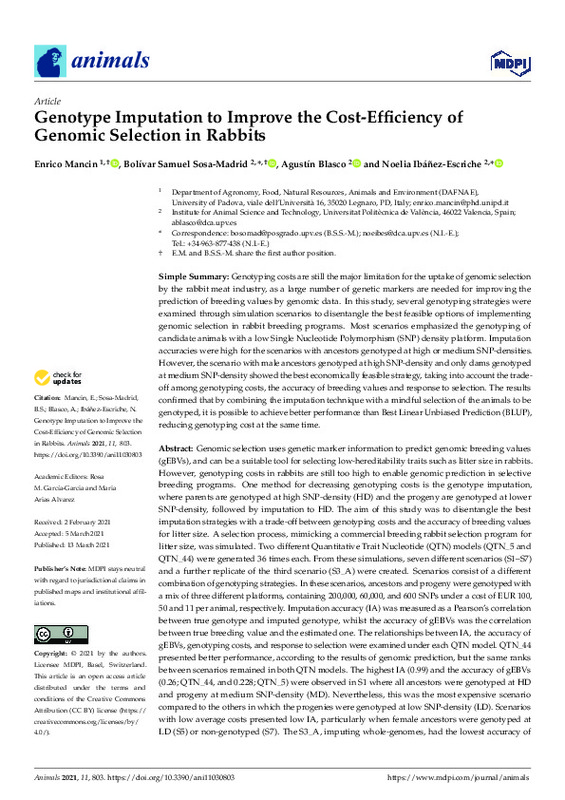|
Resumen:
|
[EN] Genomic selection uses genetic marker information to predict genomic breeding values (gEBVs), and can be a suitable tool for selecting low-hereditability traits such as litter size in rabbits. However, genotyping costs ...[+]
[EN] Genomic selection uses genetic marker information to predict genomic breeding values (gEBVs), and can be a suitable tool for selecting low-hereditability traits such as litter size in rabbits. However, genotyping costs in rabbits are still too high to enable genomic prediction in selective breeding programs. One method for decreasing genotyping costs is the genotype imputation, where parents are genotyped at high SNP-density (HD) and the progeny are genotyped at lower SNP-density, followed by imputation to HD. The aim of this study was to disentangle the best imputation strategies with a trade-off between genotyping costs and the accuracy of breeding values for litter size. A selection process, mimicking a commercial breeding rabbit selection program for litter size, was simulated. Two different Quantitative Trait Nucleotide (QTN) models (QTN_5 and QTN_44) were generated 36 times each. From these simulations, seven different scenarios (S1-S7) and a further replicate of the third scenario (S3_A) were created. Scenarios consist of a different combination of genotyping strategies. In these scenarios, ancestors and progeny were genotyped with a mix of three different platforms, containing 200,000, 60,000, and 600 SNPs under a cost of EUR 100, 50 and 11 per animal, respectively. Imputation accuracy (IA) was measured as a Pearson's correlation between true genotype and imputed genotype, whilst the accuracy of gEBVs was the correlation between true breeding value and the estimated one. The relationships between IA, the accuracy of gEBVs, genotyping costs, and response to selection were examined under each QTN model. QTN_44 presented better performance, according to the results of genomic prediction, but the same ranks between scenarios remained in both QTN models. The highest IA (0.99) and the accuracy of gEBVs (0.26; QTN_44, and 0.228; QTN_5) were observed in S1 where all ancestors were genotyped at HD and progeny at medium SNP-density (MD). Nevertheless, this was the most expensive scenario compared to the others in which the progenies were genotyped at low SNP-density (LD). Scenarios with low average costs presented low IA, particularly when female ancestors were genotyped at LD (S5) or non-genotyped (S7). The S3_A, imputing whole-genomes, had the lowest accuracy of gEBVs (0.09), even worse than Best Linear Unbiased Prediction (BLUP). The best trade-off between genotyping costs and the accuracy of gEBVs (0.234; QTN_44 and 0.199) was in S6, in which dams were genotyped with MD whilst grand-dams were non-genotyped. However, this relationship would depend mainly on the distribution of QTN and SNP across the genome, suggesting further studies on the characterization of the rabbit genome in the Spanish lines. In summary, genomic selection with genotype imputation is feasible in the rabbit industry, considering only genotyping strategies with suitable IA, accuracy of gEBVs, genotyping costs, and response to selection.
[-]
|
|
Agradecimientos:
|
This research study was funded by AGL2017-86083-C2-P1 from "Plan Nacional de Investigacion Cientifica" of Spain-Project I+D. B. Samuel Sosa Madrid was supported by FPI grant, number BES-2015-074194, from "Ministerio de ...[+]
This research study was funded by AGL2017-86083-C2-P1 from "Plan Nacional de Investigacion Cientifica" of Spain-Project I+D. B. Samuel Sosa Madrid was supported by FPI grant, number BES-2015-074194, from "Ministerio de Ciencia e Innovacion".
[-]
|









